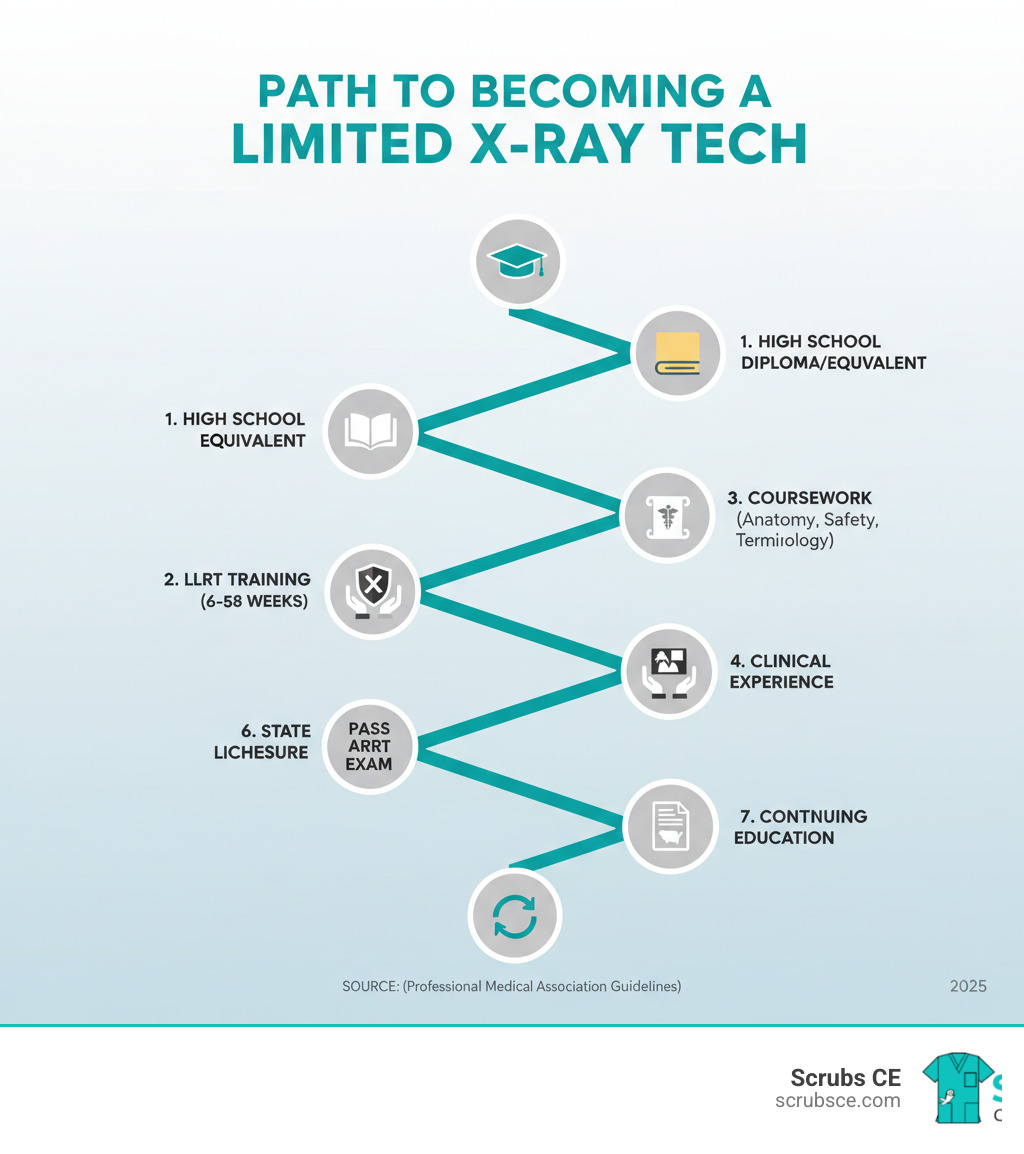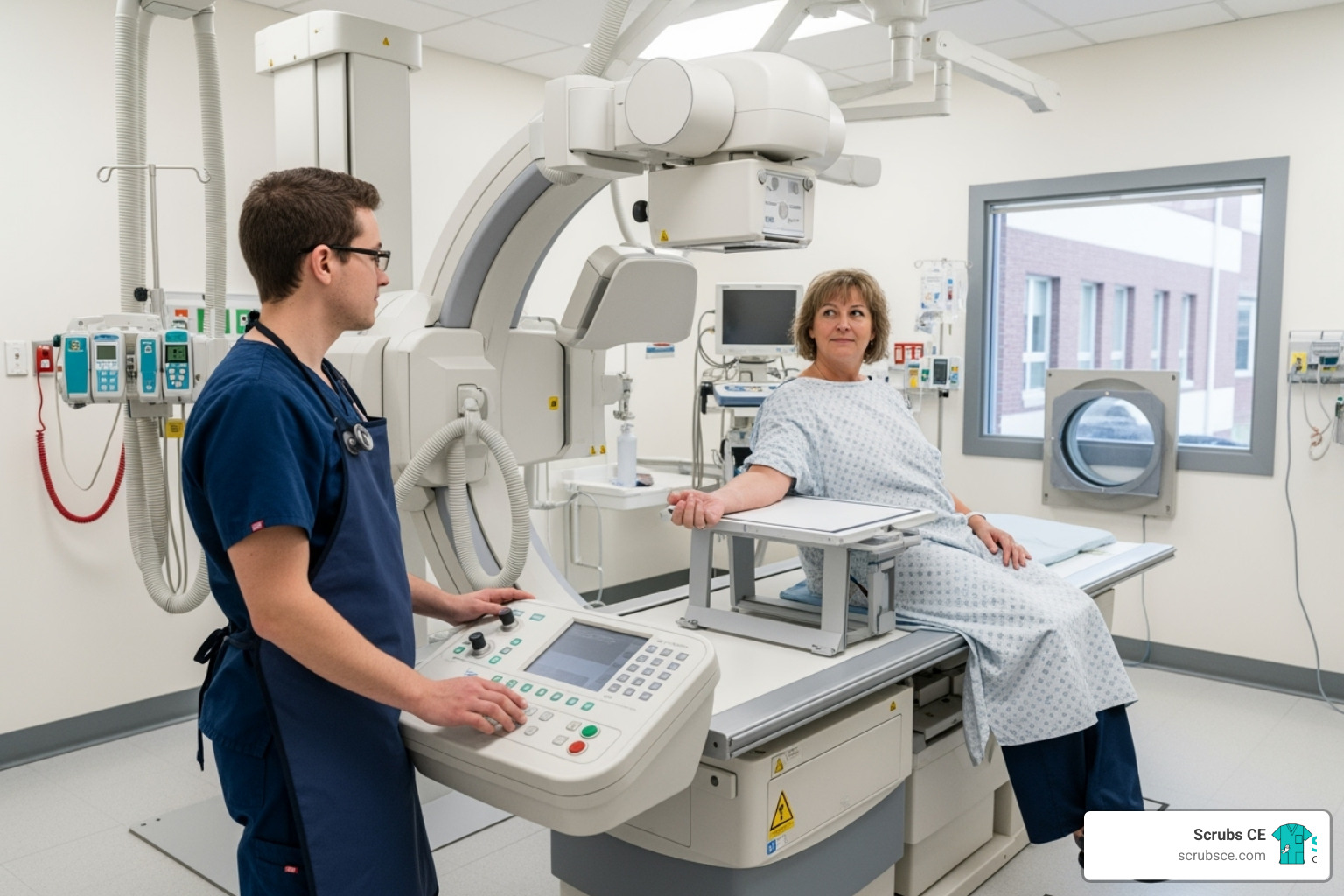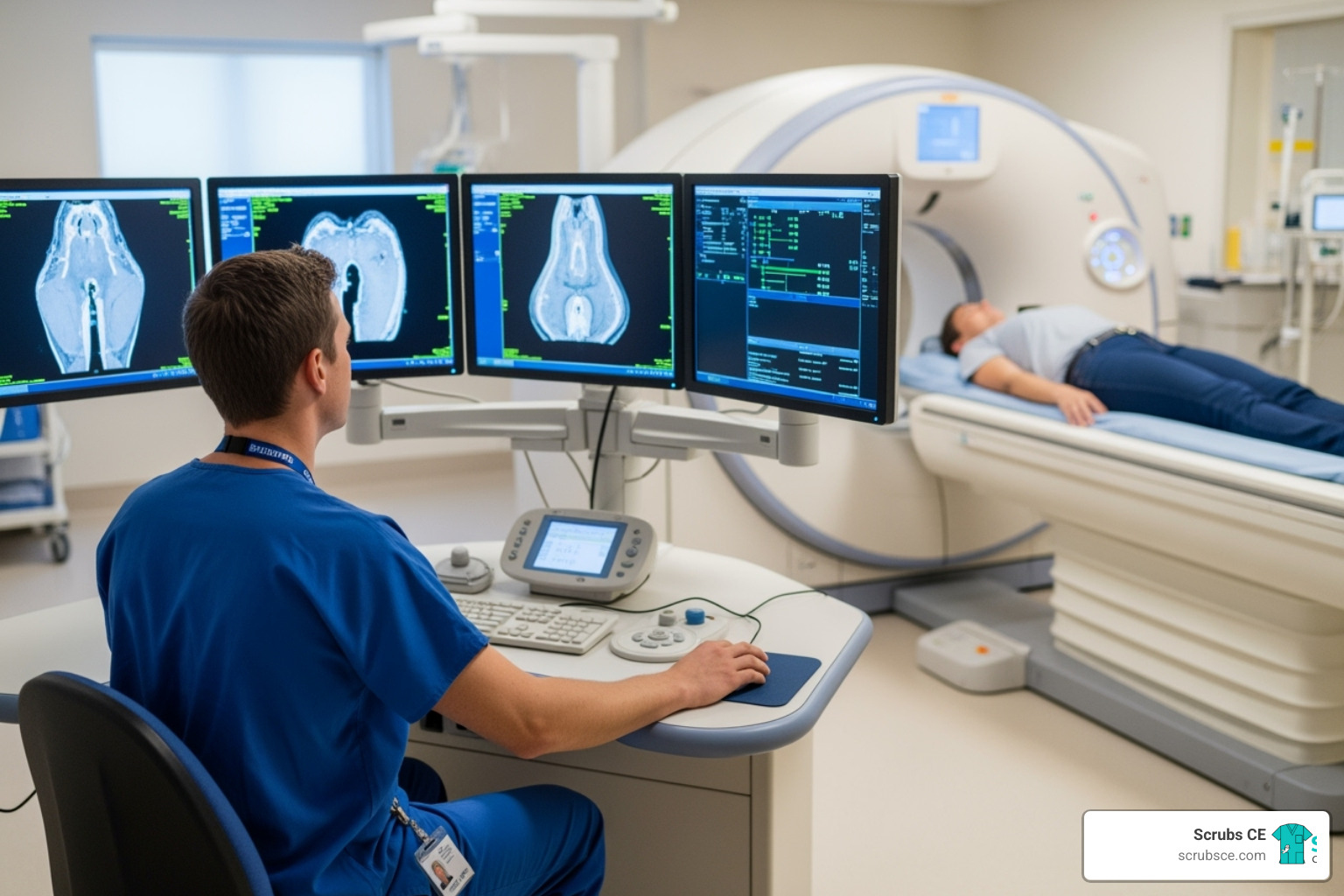What is a Limited License Radiologic Tech?
A limited license radiologic tech is a healthcare professional who operates X-ray equipment to capture diagnostic images of specific body parts under the supervision of a licensed physician or radiologic technologist. These entry-level technologists perform a focused scope of radiographic procedures, typically on extremities, the chest, spine, and skull, helping physicians diagnose injuries and medical conditions.
Quick Overview: Limited License Radiologic Technologist
- Role: Perform X-rays on specific body parts (chest, extremities, spine, skull)
- Work Settings: Urgent care centers, physician offices, orthopedic clinics, chiropractic offices
- Training Time: 6-9 weeks to 58 weeks, depending on program
- Certification: ARRT Limited Scope of Practice in Radiography Exam (required in most states)
- Supervision: Work under a licensed physician or full radiologic technologist
- Career Entry: Faster path into healthcare than full RT certification
If you’re considering a career in medical imaging but want a quicker entry point than becoming a full radiologic technologist, becoming a limited license radiologic tech might be your ideal path. This role offers a way to start working in healthcare sooner while still playing a crucial part in patient diagnosis and care.
The demand for diagnostic imaging continues to grow as the population ages and healthcare facilities expand. Limited license radiologic techs fill an important gap, especially in outpatient settings, urgent care facilities, and specialty clinics where their focused expertise is exactly what’s needed.
This guide walks you through everything you need to know about becoming a limited license radiologic tech, from understanding the role and educational requirements to certification, state licensing, and career advancement opportunities. Whether you’re just starting your healthcare journey or looking to add a credential to your existing skills, this roadmap will help you steer the process.
Understanding the Role of a Limited License Radiologic Tech
If you’re curious about what a limited license radiologic tech actually does day-to-day, you’re in the right place. This role is much more than operating an X-ray machine—it’s a blend of technical expertise, compassionate patient care, and meticulous attention to detail that helps physicians diagnose everything from broken bones to chest infections.
Think of an LLRT as a focused specialist in medical imaging. While the job is considered entry-level, it’s perfect for people who want to make a real difference in healthcare without spending years in school. Many people who become LLRTs already work in healthcare as certified clinical medical assistants or certified nursing assistants, and they’re looking to expand their skills and career options.
What is a Limited License Radiologic Technologist (LLRT)?
A limited license radiologic tech, sometimes called an X-ray technician or Limited Medical Radiologic Technologist (LMRT), is trained to perform specific diagnostic X-ray procedures on certain parts of the body. The key word here is “limited”—unlike full radiologic technologists who can operate advanced imaging equipment like CT scanners and MRI machines, LLRTs focus on a narrower scope of practice.
This focused approach is actually a benefit. It means you can complete your training much faster and start working in healthcare sooner. Your training zeroes in on the essential skills you need: positioning patients correctly, operating X-ray equipment safely, understanding radiation safety protocols, and ensuring image quality for accurate diagnosis.
As an LLRT, you work under the supervision of a licensed physician or a full radiologic technologist. This doesn’t mean someone is looking over your shoulder every second—it means you’re part of a healthcare team with proper oversight to ensure patient safety and proper imaging protocols. You’re a key player in settings where broad imaging expertise isn’t needed but quality X-rays absolutely are, like urgent care centers, orthopedic clinics, and physician offices.
Your mission is straightforward but vital: capture clear, accurate images that help physicians diagnose medical conditions quickly. Whether it’s a child’s fractured arm, a worker’s injured back, or a patient’s chest X-ray to rule out pneumonia, the images you produce directly impact treatment decisions and patient outcomes.
Primary Duties and Work Environments
The daily work of a limited license radiologic tech is hands-on and patient-centered. You spend your day interacting with people who are often anxious or in pain, which means your communication skills matter just as much as your technical abilities.
Patient positioning is one of your core responsibilities. Getting the angle just right makes the difference between a clear diagnostic image and one that needs to be retaken. This requires solid knowledge of anatomy and radiographic positioning techniques. You’ll adjust both the patient and the equipment until everything aligns perfectly for the image the physician needs.
Operating radiographic equipment safely is at the heart of what you do. You’ll set the correct exposure factors, ensure proper shielding to minimize radiation exposure, and capture images using the lowest radiation dose possible. Modern X-ray machines are sophisticated, and you’ll become expert at using them efficiently while following strict safety protocols.
Once you capture an image, processing and preparing it for physician review is your next step. In most settings today, this means working with digital imaging systems—labeling images correctly, checking quality, and making sure everything is uploaded to the patient’s medical record properly.
Patient safety and communication run through everything you do. You’ll explain procedures in simple terms to ease anxiety, answer questions, position lead shields to protect sensitive areas from radiation, and make sure patients feel cared for during what can be an uncomfortable experience. Your calm, professional demeanor helps patients trust the process.
You’ll also handle basic equipment maintenance—checking that machines are functioning correctly, reporting any issues, and ensuring your workspace meets safety standards.
Where do LLRTs work? Your focused skill set makes you valuable in outpatient and specialized settings. Urgent care centers rely on LLRTs to quickly image common injuries like sprains, fractures, and suspected broken bones. Physician’s offices, particularly in primary care and family medicine, need someone who can take basic X-rays right there in the office. Orthopedic clinics are a natural fit since you’re imaging bones and joints—exactly what an LLRT is trained to do.
Chiropractic offices use LLRTs to assess spinal alignment and skeletal issues. Ambulatory care centers and occupational medicine clinics also employ LLRTs for convenient outpatient imaging without sending patients to larger hospitals. In all these environments, you’re the person who makes diagnostic imaging accessible, efficient, and patient-friendly.
LLRT vs. Full Radiologic Technologist (RT): Key Differences
When you’re considering a career in radiologic technology, one of the first questions that usually comes up is, “Should I become a limited license radiologic tech (LLRT) or go for the full Radiologic Technologist (RT) certification?” It’s an important choice, and understanding the key differences between these two paths will help you make a decision that truly fits your career goals, timeline, and lifestyle.
Both roles are essential to diagnostic imaging, and both involve working directly with patients and X-ray equipment. However, they differ significantly in their scope of practice, the education required, where you’ll typically work, and what you can expect to earn. Let’s break down these differences so you can see which path might be the right fit for you.
Here’s a quick side-by-side comparison to give you the big picture:
| Feature | Limited License Radiologic Technologist (LLRT) | Full Radiologic Technologist (RT) |
|---|---|---|
| Scope of Practice | Limited to specific body parts (chest, extremities, spine, skull); basic X-ray procedures only | Broad scope including all X-ray procedures, plus advanced modalities like CT, MRI, fluoroscopy, and mammography |
| Education | Certificate programs ranging from 6-9 weeks to 58 weeks | Associate’s degree (2 years) or Bachelor’s degree (4 years) |
| Typical Workplaces | Urgent care centers, physician offices, orthopedic clinics, chiropractic offices, small outpatient facilities | Hospitals, large medical centers, specialized imaging centers, plus all LLRT settings |
| Salary Potential | Generally lower, entry-level wages | Higher earning potential with more opportunities for advancement and specialization |
Scope of Practice and Procedures
The most fundamental difference between an LLRT and a full RT is what you’re authorized to do. As a limited license radiologic tech, your scope of practice is, as the name suggests, limited. You’re trained and certified to perform X-rays on specific anatomical areas—typically bony anatomy such as extremities (arms, legs, hands, feet), the chest, spine, and skull. This focused scope is perfect for settings where these specific types of imaging are most common.
However, there are procedures you cannot perform as an LLRT. You won’t be authorized to conduct fluoroscopy (real-time moving X-ray images) or contrast studies (imaging that uses contrast dyes to visualize organs and blood vessels). These more complex procedures require the broader training of a full RT.
In contrast, a full Radiologic Technologist has a much broader scope of practice. They can perform all the basic X-ray procedures that an LLRT does, plus they’re trained in advanced modalities like CT scans (computed tomography), MRI (magnetic resonance imaging), and mammography. This versatility opens doors to more diverse work environments and specialized roles within medical imaging.
Pros and Cons: LLRT vs. RT Certification
So which path should you choose? Like most career decisions, it depends on your personal circumstances, goals, and priorities. Let’s look at the advantages and limitations of each route.
For LLRTs, the biggest advantage is faster training. You can complete your education in as little as 6-9 weeks, though more comprehensive programs may take up to a year. This means you can start working and earning much sooner than if you pursued a full RT degree. Another major plus is the lower education cost—certificate programs are significantly less expensive than associate’s or bachelor’s degree programs. And finally, you get quicker entry to the workforce, which is ideal if you need to start earning income soon or want to test the waters in medical imaging before committing to a longer educational path.
On the flip side, LLRTs face some constraints. Your limited scope means you’ll only be qualified for certain positions, typically in smaller outpatient settings. The lower salary potential reflects both the shorter training period and the more limited responsibilities. And if you want to advance your career, you’ll likely need to pursue additional education to expand your credentials—there are fewer advancement options without going back to school.
For full RTs, the primary advantages include higher earning potential right from the start, more job opportunities across a wider range of healthcare settings, and specialization options that can further boost your career and salary. You’ll have the flexibility to work in hospitals, imaging centers, or specialized fields like pediatric radiology or interventional radiology.
The trade-offs for becoming a full RT are straightforward: longer education (typically two to four years) and higher cost for your degree program. You’ll also need to commit more time before you can start working in the field.
Choosing between becoming a limited license radiologic tech and a full RT comes down to your timeline, budget, and career ambitions. If you want to enter healthcare quickly and are comfortable with a focused role, the LLRT path offers a practical and rewarding entry point. If you’re willing to invest more time and money upfront for broader opportunities and higher earning potential, the full RT certification might be your better choice. And here’s the good news: many LLRTs later decide to pursue their full RT credentials through bridge programs, so your initial choice doesn’t have to be permanent.




Recent Comments